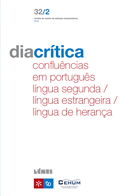A gramática no ensino de línguas baseado em tarefas
DOI:
https://doi.org/10.21814/diacritica.5096Palavras-chave:
Ensino de línguas baseado em tarefas, Foco na forma, Materiais didáticosResumo
Apesar de não ser um aspeto central, o ensino da gramática – isto é, o recurso a tarefas específicas e/ou a outro tipo de estratégias com a finalidade de chamar a atenção dos estudantes para determinados aspetos linguísticos sem que deixe de haver um foco predominante na mensagem – desempenha um papel importante no Ensino de Línguas Baseado em Tarefas (ELBT), sendo incorreto reivindicar o contrário. Não obstante, também é verdade que, no ELBT, se procura evitar o ensino explícito de itens linguísticos predeterminados, que tende a ser privilegiado nos métodos tradicionalmente adotados no ensino de segundas línguas (L2), por não ser considerado um procedimento compatível com o processo de aquisição de L2, à luz do que sobre ele se sabe. Partindo da clarificação do conceito de foco na forma, o presente artigo tem como finalidade exemplificar, em particular, o modo como, no ELBT, se pode trabalhar a gramática e promover a atenção dos estudantes de Português como Língua Estrangeira, de nível inicial, para estruturas e aspetos linguísticos específicos, com recurso a tarefas com foco e a estratégias metodológicas.
Referências
Bielsa, P. B., Catalán G. S., Tapia, M. Á. D., Ripoll, S. L., Samaniego, A. L. & López, J. M. (2009). Destino Erasmus 1. Barcelona, Espanha: Universitat de Barcelona/SGEL
Educación.
Bygate, M. & Samuda, V. (2009). Creating Pressure in Task Pedagogy. In A. Mackey & C. Polio (Eds.), Multiple Perspectives on Interaction (pp. 90-116). Londres, Inglaterra: Routledge.
Castro, C. (2015). Materiais para o ensino do português como língua estrangeira: uma proposta de aprendizagem baseada em tarefas (Tese de doutoramento, Universidade Nova de Lisboa).
Castro, C. (2017). Ensino de línguas baseado em tarefas: Da teoria à prática. Lisboa, Portugal: Lidel Edições Técnicas.
Ellis, R. (1991). Second language acquisition and second language pedagogy. Clevedon, Inglaterra: Multilingual Matters.
Ellis, R. (1993). Second language acquisition and the structural syllabus. TESOL Quarterly, 27(1), 91–113. DOI: https://doi.org/10.2307/3586953
Ellis, R. (1995). Interpretation tasks for grammar teaching. TESOL Quarterly, 29(1), 87-105. DOI: https://doi.org/10.2307/3587806
Ellis, R. (1999). Input based approaches to teaching grammar: A review of classroom oriented research. DOI: https://doi.org/10.1017/S0267190599190044
Annual Review of Applied Linguistics, 19(1), 64-80.
Ellis, R. (2003). Task-Based language learning and teaching. Oxford, Inglaterra: Oxford University Press.
Ellis, R. (2009). Task-based language teaching: Sorting out the misunderstandings. International Journal of Applied Linguistics, 19(3), 221-246. DOI: https://doi.org/10.1111/j.1473-4192.2009.00231.x
Ellis, R., Basturkmen, H. & Loewen, S. (2001). Learner uptake in communicative ESL lessons. Language Learning, 51(2), 281-318. DOI: https://doi.org/10.1111/1467-9922.00156
Ellis, R. & Shintani, N. (2014). Exploring language pedagogy through second language acquisition. Londres, Inglaterra: Routledge. DOI: https://doi.org/10.4324/9780203796580
Jourdenais, R., Ota, M., Stauffer, S., Boyson, B. &
Doughty, C. (1995). Does textual enhancement promote noticing? A think aloud protocol analysis. In R. Schmidt (Ed.), Attention and Awareness in Foreign Language Learning (pp. 183216). Honolulu, Estados Unidos da América: University of Hawaii Press.
Long, M. (1985). A role for instruction: Task-based
language teaching. In M. Pienemann & K. Hyltenstam (Eds.), Modeling and Assessing Second Language Acquisition (pp. 77-99) Mahwah, Estados Unidos da América: Erlbaum.
Long. M. (1988). Instructed Second Language Acquisition. In L. Beebe (Ed.), Issues in second language acquisition: Multiple perspectives (pp. 113-147). Nova Iorque, Estados Unidos da América: Newbury House.
Long, M. (1991). Focus on form: A design feature in language teaching methodology. In K. Bot, R. Ginsberg & C. Kramsch (Eds.), Foreign language research in crosscultural perspective (pp. 39-52). Amsterdão, Holanda: John Benjamins. DOI: https://doi.org/10.1075/sibil.2.07lon
Long, M. & Crookes, G. (1992). _Three approaches to task-based syllabus design. TESOL Quarterly, 26(1), 27-56. DOI: https://doi.org/10.2307/3587368
Loschky, L. & Bley-Vroman, R. (1993). Grammar and task-based methodology. In S. M. Gass & G. Crookes (Eds.), Tasks and Language Learning (pp. 123-67). Clevedon, Inglaterra: Multilingual Matters.
Lyster, R. & Ranta, L. (1997). Corrective feedback and learner uptake: Negotiation of form in communicative classrooms. Studies in Second Language Acquisition, 19(1), 3766. DOI: https://doi.org/10.1017/S0272263197001034
Mackey, A. (1999). Input, Interaction and Second Language Development. Studies in Second Language Acquisition, 21(1), 557–587. DOI: https://doi.org/10.1017/S0272263199004027
Mackey, A. (2012). Input, interaction and corrective feedback in L2 learning. Oxford, Inglaterra: Oxford University Press.
Samuda, V. & Bygate, M. (2008). Tasks in second language learning. Nova Iorque, Estados Unidos da América: Palgrave Macmillan. DOI: https://doi.org/10.1057/9780230596429
Sheen, R. (2003). Focus-on-Form: A myth in the making. ELT Journal, 57(2), 225-233. DOI: https://doi.org/10.1093/elt/57.3.225
Shintani, N., Li, S. & Ellis, R. (2013). Comprehension-based versus production-based grammar intruction: A meta-analysis of comparative studies. Language Learning, 63(2), 296-329. DOI: https://doi.org/10.1111/lang.12001
Skehan, P. (1998a). A cognitive approach to language learning. Oxford, Inglaterra: Oxford
University Press.
Skehan, P. (1998b). Task-Based Instruction. Annual Review of Applied Linguistics, 18, pp. 268-286. DOI: https://doi.org/10.1017/S0267190500003585
Swan, M. (2005). Legislating by hypothesis: The case of task-based instruction. Applied Linguistics, 26(3), 376-401. DOI: https://doi.org/10.1093/applin/ami013
Tavares, A. (2003). Português XXI-1: Livro do aluno. Lisboa, Portugal: Lidel.
Trahey, M. & White, L. (1993). Positive evidence and preemption in the second language classroom. Studies in Second Language Acquisition, 15(2), 181-204. DOI: https://doi.org/10.1017/S0272263100011955
Tuz, E. (1993). From controlled practice to communicative activity: Does training transfer?. TESOL, 1, 97-108.
VanPatten, B. (1996). Input processing and grammar instruction. Nova Iorque, Estados Unidos da América: Ablex.
White, J. (1998). Getting the learners’ attention: A typographical input enhacement study. In C. Doughty & J. Williams (Eds.), Focus on Form in Classroom Second Language Acquisition (pp. 85-113). Cambridge, Inglaterra: Cambridge University Press.
Willis, D. & Willis, J. J. (2007). Doing Task-Based Teaching. Oxford, Inglaterra: Oxford University Press.
Downloads
Publicado
Como Citar
Edição
Secção
Licença
Direitos de Autor (c) 2023 Catarina Castro

Este trabalho encontra-se publicado com a Creative Commons Atribuição-NãoComercial 4.0.










